2019 NISSAN TITAN maintenance
[x] Cancel search: maintenancePage 604 of 682
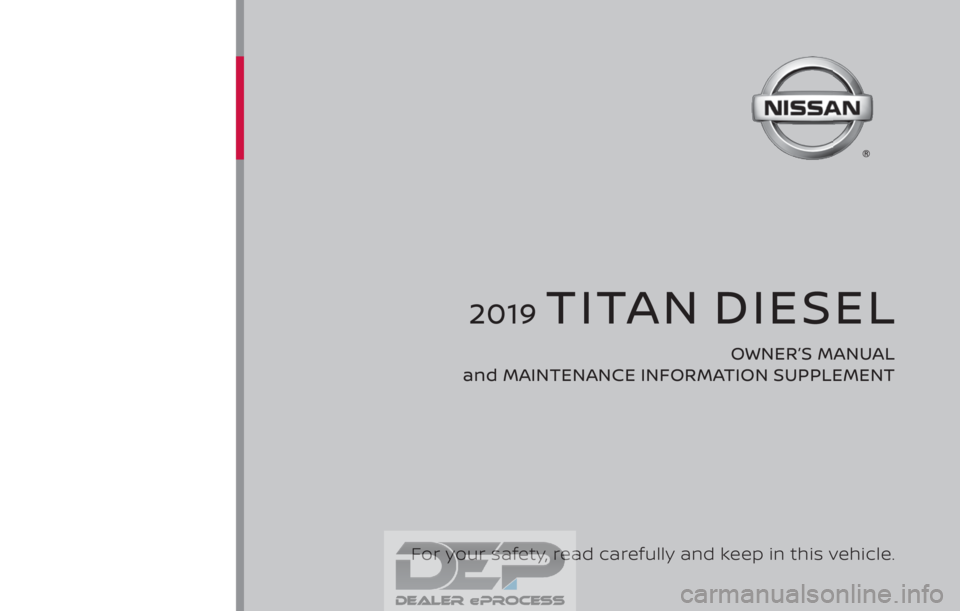
2019 TITAN DIESEL
OWNER’S MANUAL
and MAINTENANCE INFORMATION SUPPLEMENT
For your safety, read carefully and keep in this vehicle.
Page 606 of 682
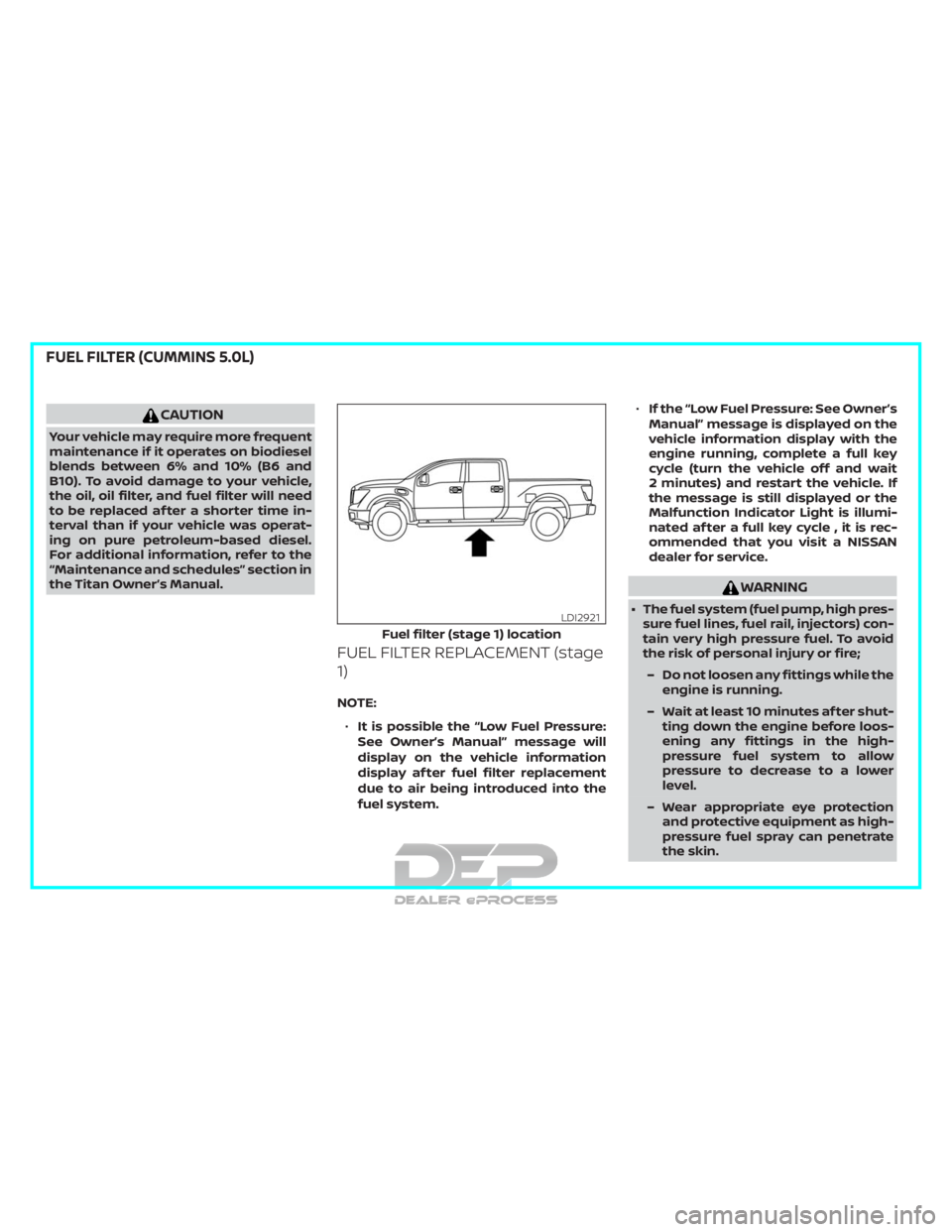
CAUTION
Your vehicle may require more frequent
maintenance if it operates on biodiesel
blends between 6% and 10% (B6 and
B10). To avoid damage to your vehicle,
the oil, oil filter, and fuel filter will need
to be replaced af ter a shorter time in-
terval than if your vehicle was operat-
ing on pure petroleum-based diesel.
For additional information, refer to the
“Maintenance and schedules” section in
the Titan Owner’s Manual.
FUEL FILTER REPLACEMENT (stage
1)
NOTE:∙ It is possible the “Low Fuel Pressure:
See Owner’s Manual” message will
display on the vehicle information
display af ter fuel filter replacement
due to air being introduced into the
fuel system. ∙
If the “Low Fuel Pressure: See Owner’s
Manual” message is displayed on the
vehicle information display with the
engine running, complete a full key
cycle (turn the vehicle off and wait
2 minutes) and restart the vehicle. If
the message is still displayed or the
Malfunction Indicator Light is illumi-
nated af ter a full key cycle , it is rec-
ommended that you visit a NISSAN
dealer for service.
WARNING
∙ The fuel system (fuel pump, high pres- sure fuel lines, fuel rail, injectors) con-
tain very high pressure fuel. To avoid
the risk of personal injury or fire;
– Do not loosen any fittings while the engine is running.
– Wait at least 10 minutes af ter shut- ting down the engine before loos-
ening any fittings in the high-
pressure fuel system to allow
pressure to decrease to a lower
level.
– Wear appropriate eye protection and protective equipment as high-
pressure fuel spray can penetrate
the skin.
Fuel filter (stage 1) location
LDI2921
FUEL FILTER (CUMMINS 5.0L)
Page 623 of 682
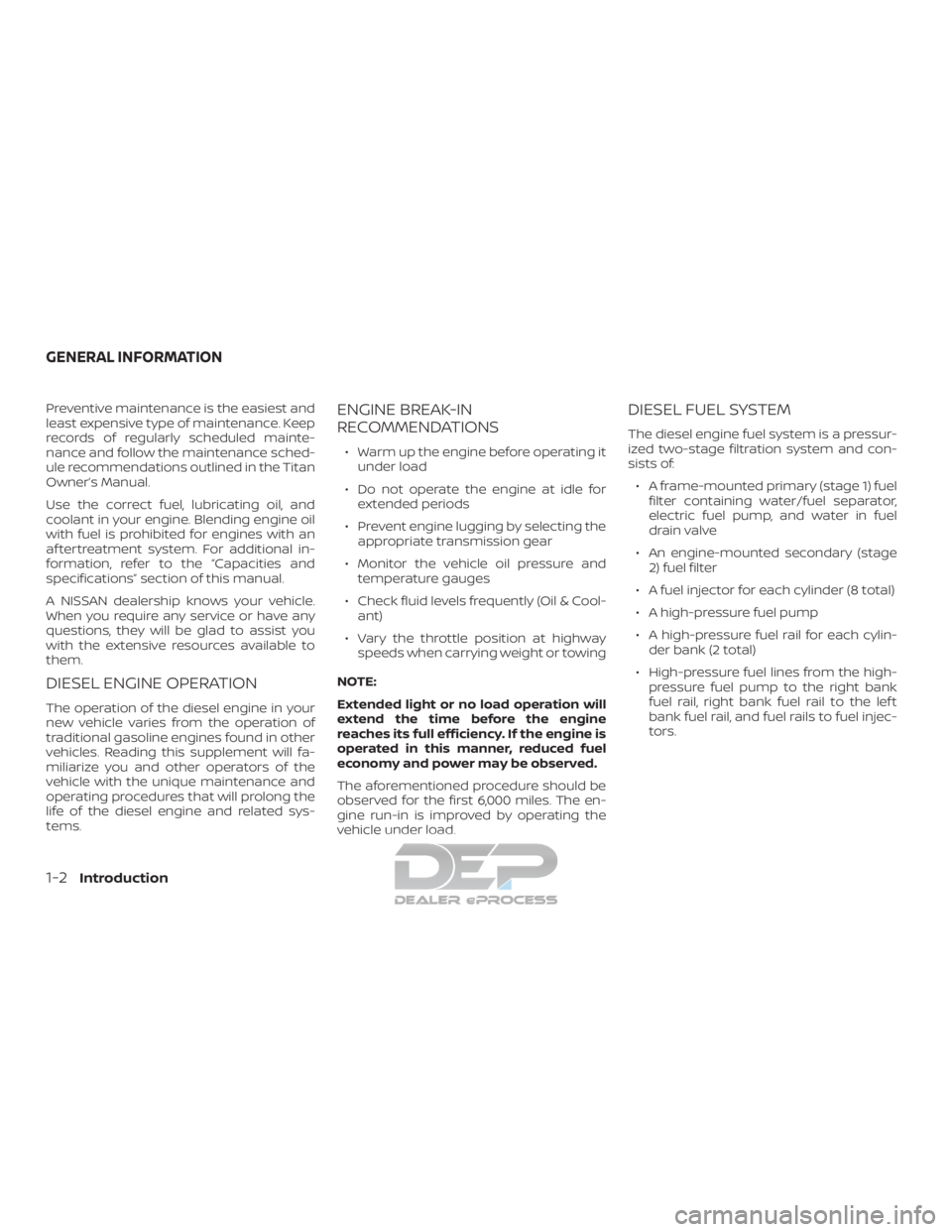
Preventive maintenance is the easiest and
least expensive type of maintenance. Keep
records of regularly scheduled mainte-
nance and follow the maintenance sched-
ule recommendations outlined in the Titan
Owner’s Manual.
Use the correct fuel, lubricating oil, and
coolant in your engine. Blending engine oil
with fuel is prohibited for engines with an
af tertreatment system. For additional in-
formation, refer to the “Capacities and
specifications” section of this manual.
A NISSAN dealership knows your vehicle.
When you require any service or have any
questions, they will be glad to assist you
with the extensive resources available to
them.
DIESEL ENGINE OPERATION
The operation of the diesel engine in your
new vehicle varies from the operation of
traditional gasoline engines found in other
vehicles. Reading this supplement will fa-
miliarize you and other operators of the
vehicle with the unique maintenance and
operating procedures that will prolong the
life of the diesel engine and related sys-
tems.
ENGINE BREAK-IN
RECOMMENDATIONS
∙ Warm up the engine before operating itunder load
∙ Do not operate the engine at idle for extended periods
∙ Prevent engine lugging by selecting the appropriate transmission gear
∙ Monitor the vehicle oil pressure and temperature gauges
∙ Check fluid levels frequently (Oil & Cool- ant)
∙ Vary the throttle position at highway speeds when carrying weight or towing
NOTE:
Extended light or no load operation will
extend the time before the engine
reaches its full efficiency. If the engine is
operated in this manner, reduced fuel
economy and power may be observed.
The aforementioned procedure should be
observed for the first 6,000 miles. The en-
gine run-in is improved by operating the
vehicle under load.
DIESEL FUEL SYSTEM
The diesel engine fuel system is a pressur-
ized two-stage filtration system and con-
sists of: ∙ A frame-mounted primary (stage 1) fuel filter containing water/fuel separator,
electric fuel pump, and water in fuel
drain valve
∙ An engine-mounted secondary (stage 2) fuel filter
∙ A fuel injector for each cylinder (8 total)
∙ A high-pressure fuel pump
∙ A high-pressure fuel rail for each cylin- der bank (2 total)
∙ High-pressure fuel lines from the high- pressure fuel pump to the right bank
fuel rail, right bank fuel rail to the lef t
bank fuel rail, and fuel rails to fuel injec-
tors.
GENERAL INFORMATION
1-2Introduction
Page 624 of 682
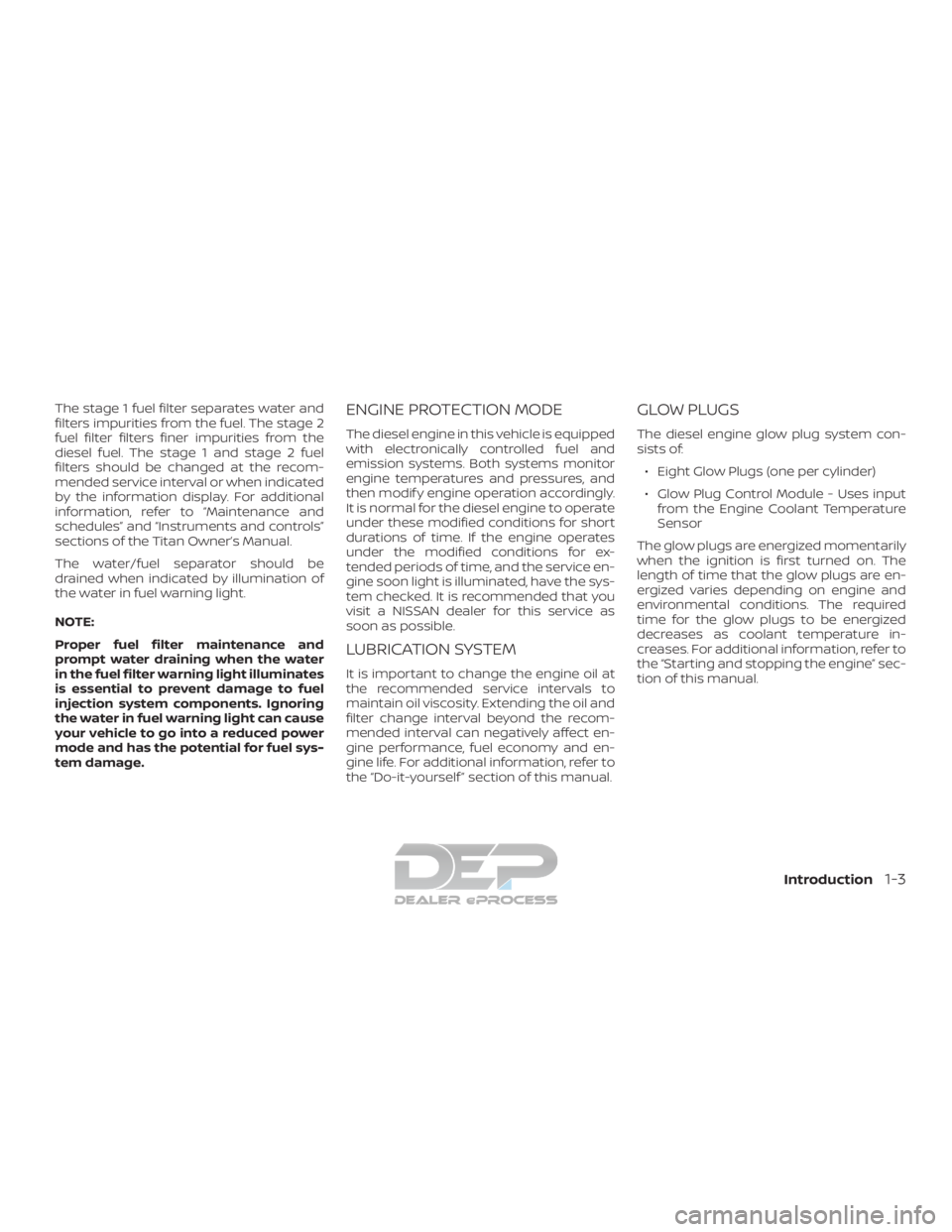
The stage 1 fuel filter separates water and
filters impurities from the fuel. The stage 2
fuel filter filters finer impurities from the
diesel fuel. The stage 1 and stage 2 fuel
filters should be changed at the recom-
mended service interval or when indicated
by the information display. For additional
information, refer to “Maintenance and
schedules” and “Instruments and controls”
sections of the Titan Owner’s Manual.
The water/fuel separator should be
drained when indicated by illumination of
the water in fuel warning light.
NOTE:
Proper fuel filter maintenance and
prompt water draining when the water
in the fuel filter warning light illuminates
is essential to prevent damage to fuel
injection system components. Ignoring
the water in fuel warning light can cause
your vehicle to go into a reduced power
mode and has the potential for fuel sys-
tem damage.ENGINE PROTECTION MODE
The diesel engine in this vehicle is equipped
with electronically controlled fuel and
emission systems. Both systems monitor
engine temperatures and pressures, and
then modif y engine operation accordingly.
It is normal for the diesel engine to operate
under these modified conditions for short
durations of time. If the engine operates
under the modified conditions for ex-
tended periods of time, and the service en-
gine soon light is illuminated, have the sys-
tem checked. It is recommended that you
visit a NISSAN dealer for this service as
soon as possible.
LUBRICATION SYSTEM
It is important to change the engine oil at
the recommended service intervals to
maintain oil viscosity. Extending the oil and
filter change interval beyond the recom-
mended interval can negatively affect en-
gine performance, fuel economy and en-
gine life. For additional information, refer to
the “Do-it-yourself ” section of this manual.
GLOW PLUGS
The diesel engine glow plug system con-
sists of:∙ Eight Glow Plugs (one per cylinder)
∙ Glow Plug Control Module - Uses input from the Engine Coolant Temperature
Sensor
The glow plugs are energized momentarily
when the ignition is first turned on. The
length of time that the glow plugs are en-
ergized varies depending on engine and
environmental conditions. The required
time for the glow plugs to be energized
decreases as coolant temperature in-
creases. For additional information, refer to
the “Starting and stopping the engine” sec-
tion of this manual.
Introduction1-3
Page 625 of 682
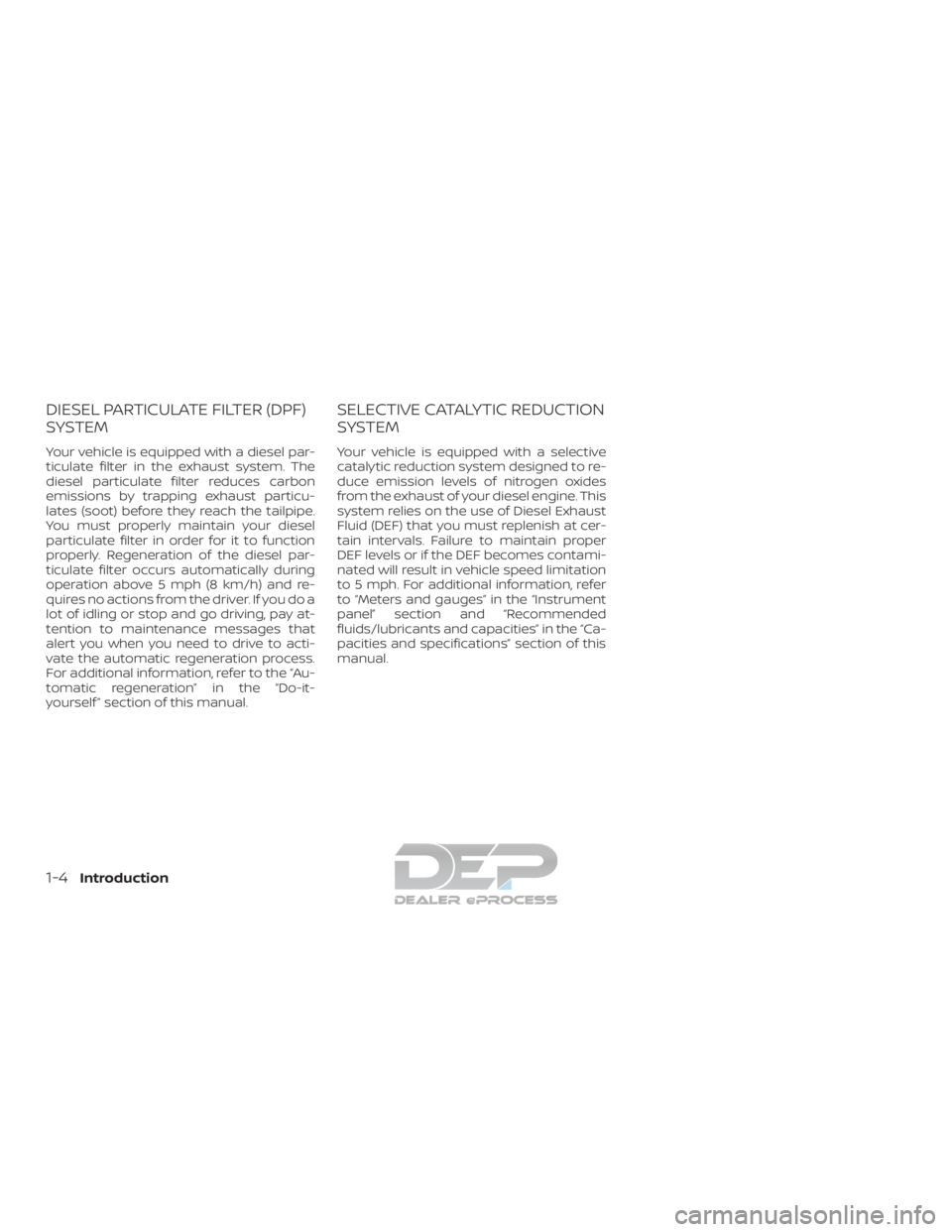
DIESEL PARTICULATE FILTER (DPF)
SYSTEM
Your vehicle is equipped with a diesel par-
ticulate filter in the exhaust system. The
diesel particulate filter reduces carbon
emissions by trapping exhaust particu-
lates (soot) before they reach the tailpipe.
You must properly maintain your diesel
particulate filter in order for it to function
properly. Regeneration of the diesel par-
ticulate filter occurs automatically during
operation above 5 mph (8 km/h) and re-
quires no actions from the driver. If you do a
lot of idling or stop and go driving, pay at-
tention to maintenance messages that
alert you when you need to drive to acti-
vate the automatic regeneration process.
For additional information, refer to the “Au-
tomatic regeneration” in the “Do-it-
yourself ” section of this manual.
SELECTIVE CATALYTIC REDUCTION
SYSTEM
Your vehicle is equipped with a selective
catalytic reduction system designed to re-
duce emission levels of nitrogen oxides
from the exhaust of your diesel engine. This
system relies on the use of Diesel Exhaust
Fluid (DEF) that you must replenish at cer-
tain intervals. Failure to maintain proper
DEF levels or if the DEF becomes contami-
nated will result in vehicle speed limitation
to 5 mph. For additional information, refer
to “Meters and gauges” in the “Instrument
panel” section and “Recommended
fluids/lubricants and capacities” in the “Ca-
pacities and specifications” section of this
manual.
1-4Introduction
Page 630 of 682
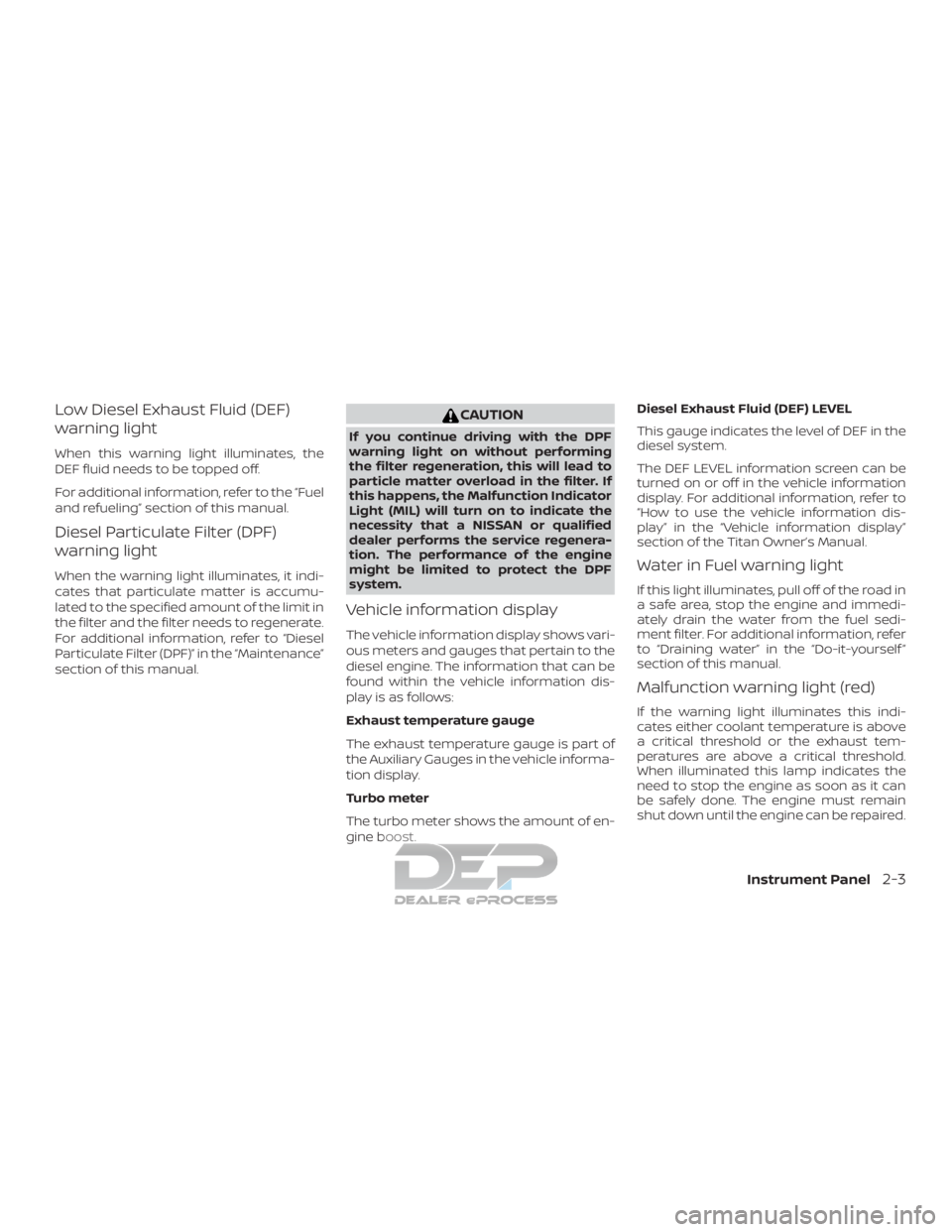
Low Diesel Exhaust Fluid (DEF)
warning light
When this warning light illuminates, the
DEF fluid needs to be topped off.
For additional information, refer to the “Fuel
and refueling” section of this manual.
Diesel Particulate Filter (DPF)
warning light
When the warning light illuminates, it indi-
cates that particulate matter is accumu-
lated to the specified amount of the limit in
the filter and the filter needs to regenerate.
For additional information, refer to “Diesel
Particulate Filter (DPF)” in the “Maintenance”
section of this manual.
CAUTION
If you continue driving with the DPF
warning light on without performing
the filter regeneration, this will lead to
particle matter overload in the filter. If
this happens, the Malfunction Indicator
Light (MIL) will turn on to indicate the
necessity that a NISSAN or qualified
dealer performs the service regenera-
tion. The performance of the engine
might be limited to protect the DPF
system.
Vehicle information display
The vehicle information display shows vari-
ous meters and gauges that pertain to the
diesel engine. The information that can be
found within the vehicle information dis-
play is as follows:
Exhaust temperature gauge
The exhaust temperature gauge is part of
the Auxiliary Gauges in the vehicle informa-
tion display.
Turbo meter
The turbo meter shows the amount of en-
gine boost.Diesel Exhaust Fluid (DEF) LEVEL
This gauge indicates the level of DEF in the
diesel system.
The DEF LEVEL information screen can be
turned on or off in the vehicle information
display. For additional information, refer to
“How to use the vehicle information dis-
play” in the “Vehicle information display”
section of the Titan Owner’s Manual.
Water in Fuel warning light
If this light illuminates, pull off of the road in
a safe area, stop the engine and immedi-
ately drain the water from the fuel sedi-
ment filter. For additional information, refer
to “Draining water” in the “Do-it-yourself ”
section of this manual.
Malfunction warning light (red)
If the warning light illuminates this indi-
cates either coolant temperature is above
a critical threshold or the exhaust tem-
peratures are above a critical threshold.
When illuminated this lamp indicates the
need to stop the engine as soon as it can
be safely done. The engine must remain
shut down until the engine can be repaired.
Instrument Panel2-3
Page 635 of 682
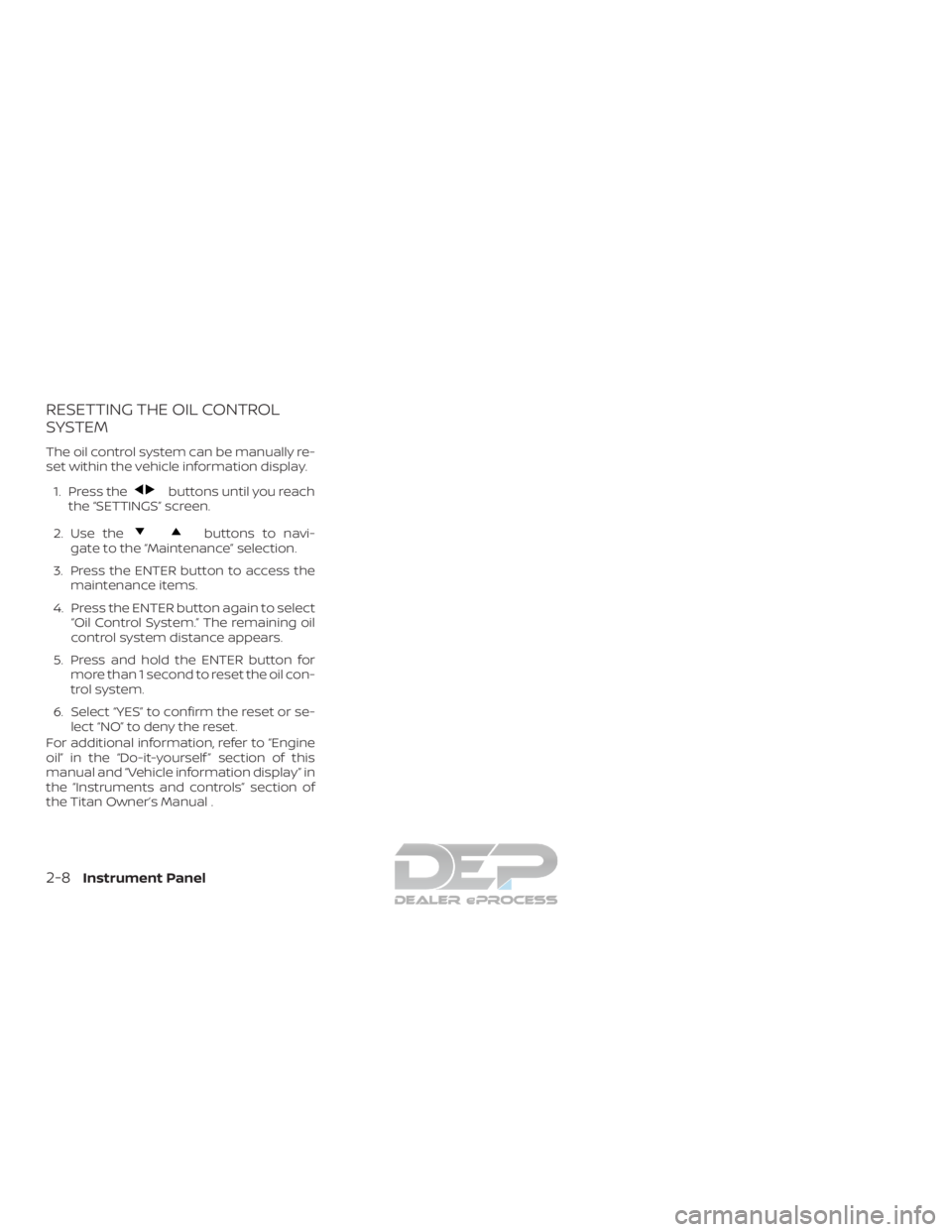
RESETTING THE OIL CONTROL
SYSTEM
The oil control system can be manually re-
set within the vehicle information display.1. Press the
buttons until you reach
the “SETTINGS” screen.
2. Use the
buttons to navi-
gate to the “Maintenance” selection.
3. Press the ENTER button to access the maintenance items.
4. Press the ENTER button again to select “Oil Control System.” The remaining oil
control system distance appears.
5. Press and hold the ENTER button for more than 1 second to reset the oil con-
trol system.
6. Select “YES” to confirm the reset or se- lect “NO” to deny the reset.
For additional information, refer to “Engine
oil” in the “Do-it-yourself ” section of this
manual and “Vehicle information display” in
the “Instruments and controls” section of
the Titan Owner’s Manual .
2-8Instrument Panel
Page 658 of 682
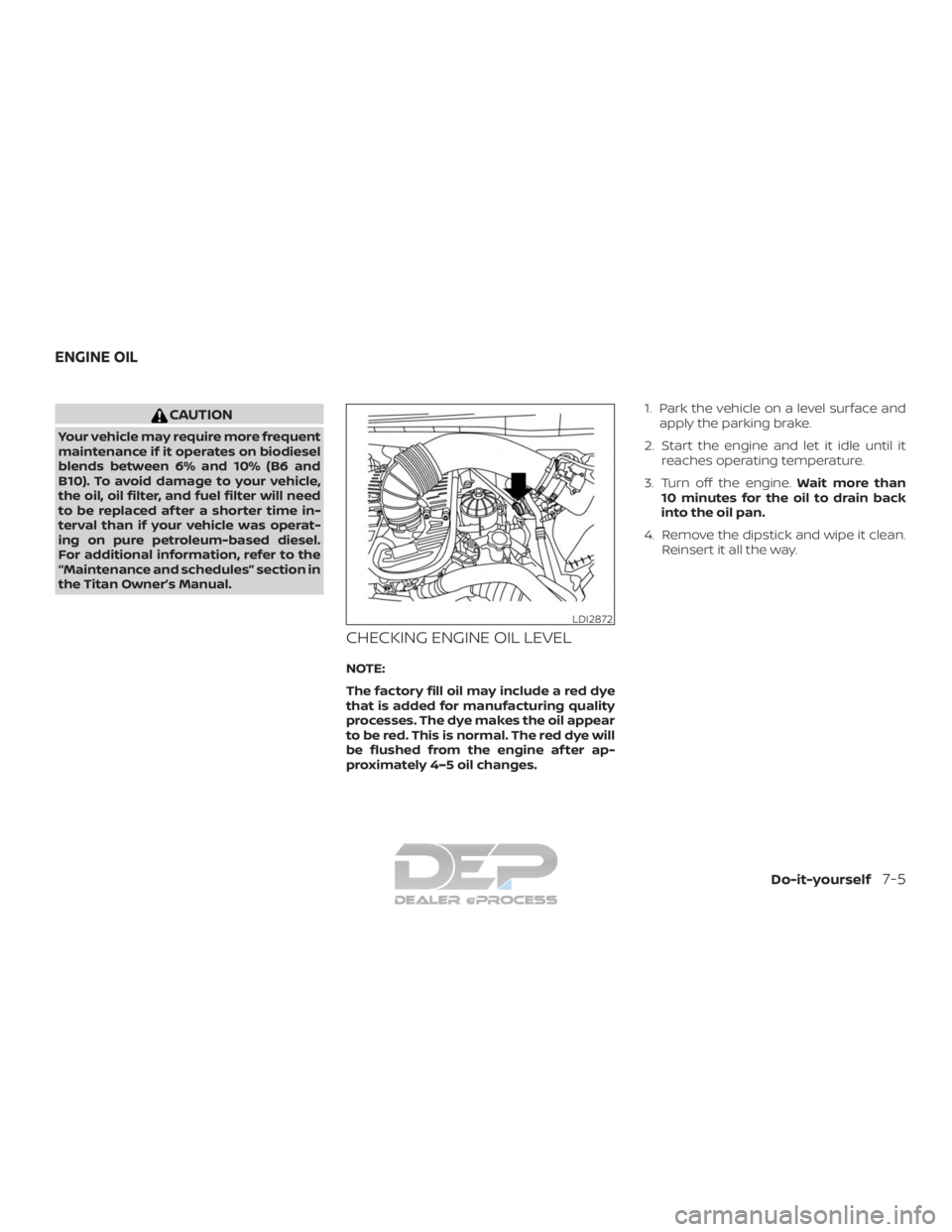
CAUTION
Your vehicle may require more frequent
maintenance if it operates on biodiesel
blends between 6% and 10% (B6 and
B10). To avoid damage to your vehicle,
the oil, oil filter, and fuel filter will need
to be replaced af ter a shorter time in-
terval than if your vehicle was operat-
ing on pure petroleum-based diesel.
For additional information, refer to the
“Maintenance and schedules” section in
the Titan Owner’s Manual.
CHECKING ENGINE OIL LEVEL
NOTE:
The factory fill oil may include a red dye
that is added for manufacturing quality
processes. The dye makes the oil appear
to be red. This is normal. The red dye will
be flushed from the engine af ter ap-
proximately 4–5 oil changes.1. Park the vehicle on a level surface and
apply the parking brake.
2. Start the engine and let it idle until it reaches operating temperature.
3. Turn off the engine. Wait more than
10 minutes for the oil to drain back
into the oil pan.
4. Remove the dipstick and wipe it clean. Reinsert it all the way.
LDI2872
ENGINE OIL
Do-it-yourself7-5